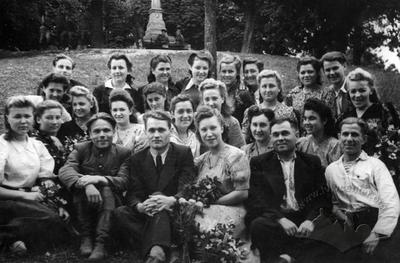Vul. Zolota – former Teofil Wiśniowski park ID: 2008
A small landscaped green space in northwest Lviv, on a hill overlooking the Krakivskyi Bazar, at the intersection of Zolota and Kleparivska Streets. Until the Second World War it was listed as a public city park. The historical name of the hill is “Execution Hill”. In 1847, Polish rebel-aristocrats Teofil Wiśniowski and Jόzef Kapuściński were executed here. In honor of their memory, in 1895 Lviv merchants erected a memorial obelisk on the hill and built a park around it with a design by the city’s leading landscape architect, Arnold Röhring.
Story
The thirty years preceding the First World War are recorded in the Lviv’s architectural log as a period of rapid territorial expansion, aggressive construction, and dynamic growth and development of Lviv’s park and garden ring. During those years the city administration pursued an ambitious schedule of plantings in the city – in the years between 1886 and 1888 alone, 60,000 trees were planted.
Lviv’s rapid modernization was also resulting in the loss of many small plots that marked the city’s ‘emerald cloak’ of green space. In particular, following the laying of the railroad line (1861) north and west of Vysoky Zamok, the city’s northwestern region was transformed into an industrial zone and an area of rapid real estate/construction development. Lost were any number of picturesque ‘garden spots’ which had beautified the area (known as the Zhovkivskyi neighborhood) through the mid-19th century. This municipal initiative was aimed at spurring growth in the city’s network of parks and gardens, and especially in this northwestern sector. Thus it was that the ground was laid for a new park on a lot adjoining the start of Kleparivska Street, on a hill where criminals had been executed during the 18th century.
Ivan Krypiakevych writes, “the north side of Janivska Street lies along high ground. There, from Kleparivska Street, at their start stands the so-called “Execution Hill” (mons supplicii), on which death sentences were regularly carried out since the 18th century. Following 1768, the Haydamaky leaders were executed here. In 1847, the Polish rebels Teofil Wiśniowski and Jόzef Kapuściński were hanged here. A monument has been put up in their honor. The locals call the place Hytslivskyi Hill, because a city “hytsel” – dog catcher – once lived in the neighborhood”, (Krypiakevych, 1991, p131).
In 1895, in memory of Teofil Wiśniowski and Jόzef Kapuściński, an obelisk by sculptor Julian Markowski was erected on Execution Hill. It was at that time that the slopes of the hill were landscaped and a square laid in which was named Wiśniowski Park, “by merit of the Wiśniowski memorial and the planting which surrounds it” (Miasto Lwów, 1896, 349).
As of this writing, the green space on Execution Hill has lost its “city park” status, and is in need of upkeep and investment.
Architecture
The former Wiśniowski Park occupies a plot of ground on Execution Hill (aka, Hytsleva or Dogcatcher Hill), a slight rise – 339m above sea level – considered part of Roztochia Hill and its significantly higher neighbor to the northwest, Kortumova Hill. The strip of land lies on an incline rising to the northwest. It is bordered on the east by Kleparivska Street, from the north by the curve of Zolota Street, and from the south by Pstrak Street. North of the park stands the former Veterans Home (currently the Lviv State University of Life Safety at 35 Kleparivska Street). The Krakivskyi Market stands across Kleparivska Street. To the south is the campus of the former Jewish hospital which runs adjacent to the territory of the razed Jewish cemetery. The center of the park square is marked by an obelisk raised in honor of Teofil Wiśniowski and Jόzef Kapuściński.
According to information dating from 1942 compiled by Olena Stepaniv, Wiśniowski Park “occupies a portion of Execution Hill along Kleparivska Street. This is a tiny green slice on a rolling plot of land. Maple, chestnut, ash, larch and other trees grow here” (Stepaniv, 1992, p47). In the early 1920s Mieczysław Orłowicz recorded that the park covered 2.8 hectares (Orłowicz, 1925, p168). Currently the green space on the corner between Zolota and Kleparivska Streets – once the city’s smallest park – is in a state of disrepair.
Related buildings and spaces
People
Teofil Wiśniowski – Polish rebel
Jόzef Kapuściński – Polish rebel
Ivan Krypiakevych – historian
Julian Markowski – sculptor
Michał Michalski – civic activist, Lviv President
Mieczysław Orłowicz – ethnographer, guidebook
author
Arnold Röhring – landscape architect, park designer
Olena Stepaniv – historian, geographer, civic activist
Sources
- Barański, F. Przewodnik po Lwowie: Z planem i widokami Lwowa. Lwów: 1902.
- Krypyakevych, Ivan. Historical Walks Around Lviv. Lviv: Kamenyar, 1991.
- Miasto Lwów w okresie samorządu 1870-1895. Lwów: 1896.
- Orłowicz, M. Ilustrowany przewodnik po Lwowie: Ze 102 ilustracjami i planem miasta. Wydanie drugie rozszerzone. Lwów – Warszawa: Książnica-Atlas, 1925.
- Stankiewicz, Z. „Ogrody i plantacje miejskie”. Lwów dawny i dzisiejszy: Praca zbiorowa pod redakcja B. Janusza.Lwów: 1928, p. 62–71.
- Stepaniv, Olena. Contemporary Lviv: A Guidebook. Lviv: Phoenix, 1992.






